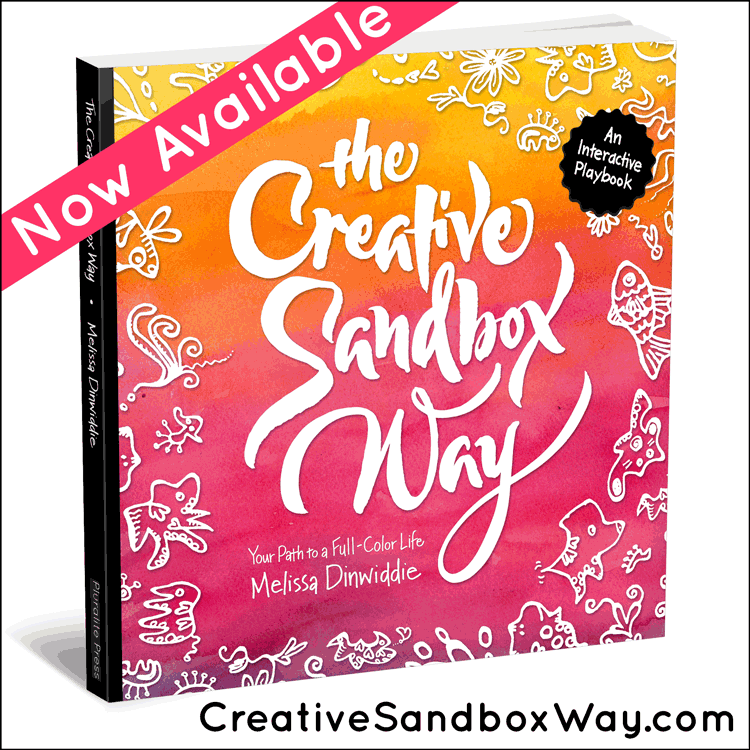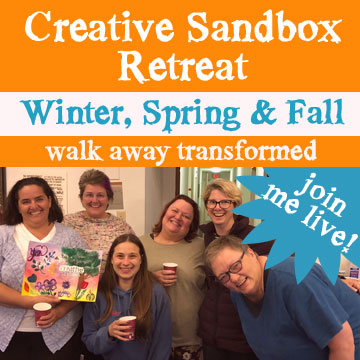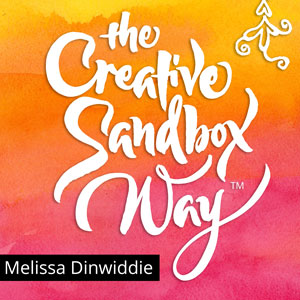Doodling seems like such a simple, mindless, “nothing” activity, doesn’t it?
But it’s actually the opposite.
I’ve been doodling just about every morning since the start of the year, and I’m discovering that it’s quite a spiritual practice.
Here’s an example.
This is a doodle I started weeks back and didn’t like at all:

“What the heck is happening here?” asked the voice in my head. “This isn’t making any sense, and I have no idea how to rescue it!”
So it languished in my sketchbook while I worked on other drawings.
Then a few days ago, after finishing a different design on another page, I was flipping through the sketchbook and encountered this one again.
I still didn’t like it.
But giving up on it entirely felt… wrong.
If I’m really going to play in the Creative Sandbox, after all, who cares if I don’t like it?
Liking it is not what the Creative Sandbox is about.
The Creative Sandbox is about playing, trying things, following curiosity, making messes.
Whether I like it or hate it is irrelevant.
So instead of starting a new doodle on a blank, white page, I decided to try adding to this one — no expectations.
Pure improvisation and “what would happen if..?”
Crap 100% allowed.
In other words, in full Creative Sandbox mode. Hello.
Over the past few days, I’ve shared these detail shots on Instagram (and Facebook and Twitter).
From Monday:

From Tuesday:

From Wednesday:

Damned if I’m not starting to like the thing more!
Instead of provoking a reaction of “meh,” this doodle is starting to interest me.
This is so often what happens.
When we release expectations, it opens us up to see what’s there, rather than only seeing what isn’t there, and how it doesn’t match up to the image in our head.
(Even when, like me, what you create is pure improvisation, and there is no image in your head! There’s still an embedded notion of “good” and “bad” that’s hard to exorcise completely… God only knows where that comes from, and how it even applies to a doodle, but it does.)
What’s really intriguing me about this, though is that this process of playing with pen and paper is revealing quirks and stylistic tropes that I keep returning to over and over.
I’m fascinated with irregular shapes, herky-jerky lines that look like they could be carved in stone, or roughly hewn out of iron with primitive tools.
Why do these shapes and lines fascinate me so? I don’t know.
What I do know is that these shapes and lines are mine.
I’m not copying anyone else. I’m not trying to produce a particular feeling or style.
I’m simply exploring what is interesting to me, and that very process is revealing my style. My voice.
In other words:
This (the space of no expectations) is also the space where your authentic voice gets to emerge and flourish.
So many people tell me their biggest desire is to find their artistic voice. The style that is uniquely theirs.
Here’s what I’m coming to understand:
The harder you pound away trying to find it, the more it hides.
Your authentic voice is shy.
It comes out when you’re NOT looking for it.
When your attention is focused on “what if..?” and following your curiosity.
When the ego drops away and you’re simply in the moment.
That’s when your true voice creeps out, tiptoes over to you and twines around your ankle.
You don’t find your true voice. When you stop trying so hard, it finds you.
Go get creating!

PS — Pssst! Know someone who might benefit from seeing this today? Pass it on!





Love your description of the Creative Sandbox as “playing, trying things, following curiosity, making messes.” Especially, “playing.”
Seems like the same definition could be applied to the word “creativity,” eh?
Your image of a true voice shyly creeping over and wrapping around your ankle wonderfully calls to mind Elizabeth Gilbert’s concept of how creative ideas find us in her book, Big Magic.
Thanks for sharing your technique!